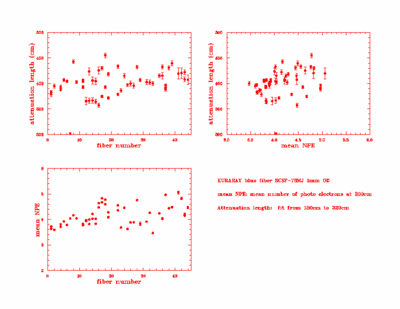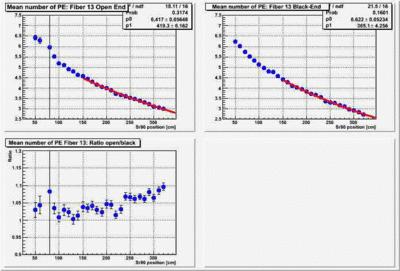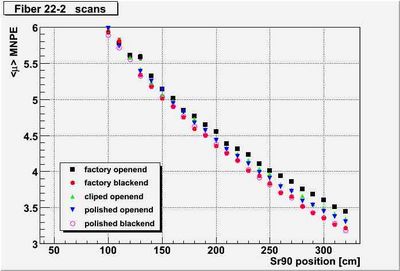Fiber Test Results K
This section shows some results from testing SCSF-78MJ fibers. The data was taken with an XP1911 PMT and a Sr90 source scanned along the 410cm long fiber. The mean number of photo electrons has been determined and the attenuation length calculated from these data beween 150cm and 320cm using
an exponential fit. Data was taken from 50cm to 320cm in steps of 10cm along the fiber. At each step the ADC spectrum is fitted and the mean number of photo electrons determined. The fiber end that was coupled to the PMT was polished, the other end was not treated. The effect of treating also the other end by painting dark and polishing will be addressed. First the final results are shown, the mean number of photo electrons at 200cm from the PMT readout
is plotted for various fibers.

For almost all fibers tests a mean number of photo electrons of more than 3.5 is found. The variation is rather large indicating some systematic effects that are not fully under control, like the quality of the fiber polishing, the coupling of the fiber to the PMT, the way the fiber is clamped etc. All these factors have not been tested but generally will lead to a smaller value of the measured mean number of photo electrons.
The attenuation length was also determined for each fiber fitting the date between 150cm and 320cm. The result of this is shown below on its own
but also as a correlation plot between attenuation length and mean number of photo electrons

From the above date the average attenuation length is 400cm with a standard deviation of 6.3%. The average mean number of photo electrons at 200cm is 4.16 with a standard deviation of 10.3%.
In addition this plot also contains scans of the same fiber where the end has been painted black. There is a systematic effect when the other end of the fiber is painted black. This reduces reflection and hence will reduce the number of photos measured. The effect is largest when the Sr90 source is positioned closest to the painted fiber end and is the smallest furthest away from it. An example of this is shown in the next plot:

About 10 fibers have been tested in this way and all fibers showed the same behavior. As an additional test one fiber was scanned several times
with its end untreated as received from the factory, painted as in the previous example, the end label clipped off with a cutter, an additional 15cm
cut off and polished and for the last scan painted. All in all 5 scans. The results of these 5 scans is shown in the plot below:

The effect of painting the fiber end black has about a 10% effect on the values close to the fiber end. Far away from the painted end the effect is small. Additional polishing of the fiber also has some effect however this effect is smaller than painting the end black. Overall treating the end of the fiber has at most a 5% effect on the mean number of photo electrons at 200cm.